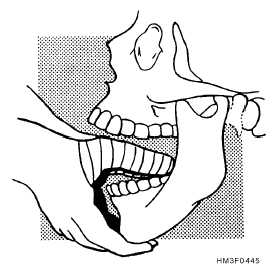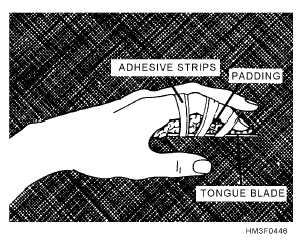dislocations (such as those of the jaw, finger, or
shoulder) if there is no arterial or nerve involvement
(pulse will be palpable and there will be no numbness
below the joint).
Treat all other dislocations as
fractures, and evacuate the victim to a definitive care
facility.
DISLOCATION OF THE JAW.—When the
lower jaw is dislocated, the victim cannot speak or
close the mouth. Dislocation of the jaw is usually
caused by a blow to the mouth; sometimes it is caused
by yawning or laughing. This type of dislocation is not
always easy to reduce, and there is considerable danger
that the operator’s thumbs will be bitten in the process.
For your own protection, wrap your thumbs with a
handkerchief or bandage. While facing the victim,
press your thumbs down just behind the last lower
molars and, at the same time, lift the chin up with your
fingers. The jaw should snap into place at once. You
will have to remove your thumbs quickly to avoid
being bitten. No further treatment is required, but you
should warn the victim to keep the mouth closed as
much as possible during the next few hours. Figure
4-45 shows the position you must assume to reduce a
dislocated jaw.
DISLOCATION OF THE FINGER.—The
joints of the finger are particularly susceptible to
injury, and even minor injuries may result in prolonged
loss of function. Great care must be used in treating
any injury of the finger.
To reduce a dislocation of the finger, grasp the
finger firmly and apply a steady pull in the same line as
the deformity. If it does not slip into position, try it
again, but if it does not go into position on the third
attempt, DO NOT TRY AGAIN. In any case, and
whether or not the dislocation is reduced, the finger
should be strapped, slightly flexed, with an aluminum
splint or with a roller gauze bandage over a tongue
blade. Figure 4-46 shows how a dislocated finger can
be immobilized by strapping it to a flat, wooden stick,
such as a tongue depressor.
DISLOCATION OF THE SHOULDER.—
Before reduction, place the victim in a supine position.
After putting the heel of your foot in the victim’s
armpit, grasp the wrist and apply steady traction by
pulling gently and increasing resistance gradually.
Pull the arm in the same line as it is found. After
several minutes of steady pull, flex the victim’s elbow
slightly. Grasp the arm below the elbow, apply traction
from the point of the elbow, and gently rotate the arm
into the external or outward position. If three reduction
attempts fail, carry the forearm across the chest and
apply a sling and swathe.
An alternate method
involves having the patient lie face down on an
examining table with the injured arm hanging over the
side. Apply prolonged, firm, gentle traction at the
wrist with gentle external rotation. A water bucket
with a padded handle placed in the crook of the
patient’s elbow may be substituted. Gradually add
sand or water to the bucket to increase traction.
Grasping the wrist and using the elbow as a pivot point,
gently rotate the arm into the external position.
Sprains
Sprains are injuries to the ligaments and soft
tissues that support a joint. A sprain is caused by the
violent wrenching or twisting of the joint beyond its
normal limits of movement and usually involves a
momentary dislocation, with the bone slipping back
into place of its own accord. Although any joint may
4-55
Figure 4-45.—Position for reducing a dislocated jaw.
Figure 4-46.—Immobilizing a dislocated finger.





